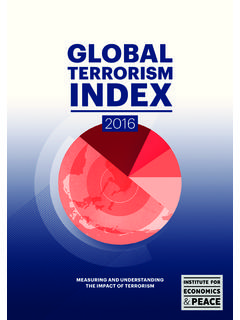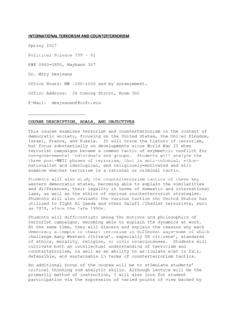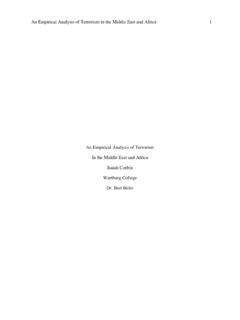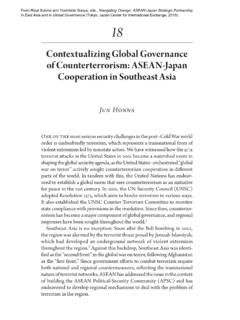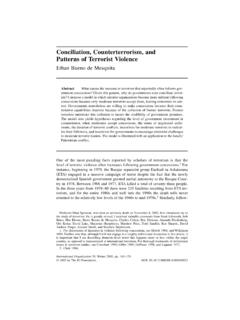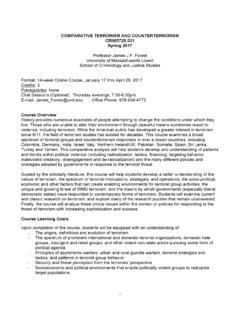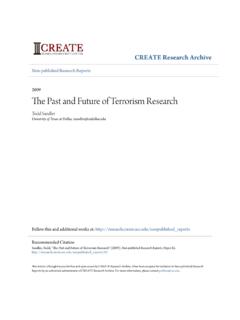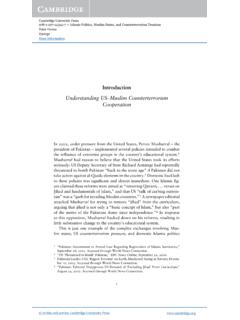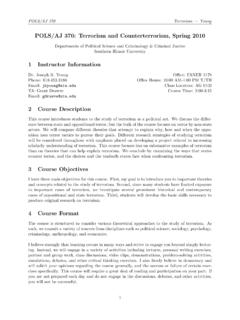Transcription of THE TECHNIQUE OF TERRORISM - Forum on Public Policy
1 Forum on Public Policy The TECHNIQUE Of TERRORISM James S. Albritton, Associate Professor of Criminal Justice, Department of Political Science &. Criminal Justice, North Georgia College & State University Abstract We are living in a radically new age of global TERRORISM , and we must seek significantly new ways of comprehending its nature and ramifications. In an effort to overcome some of the traditional obstacles to defining and understanding TERRORISM in terms of its aims and motives, the author proposes a means-based conception that allows for a more comprehensive, holistic approach to the terrorist phenomenon. The term TECHNIQUE is used to denote the vast array of means, methods, weapons, and strategies commonly employed by contemporary terrorists, as well as to define the unique nature of the global terrorist presence.
2 In this regard, the author argues that today's TERRORISM is best understood by the techniques it employs, rather than the goals it pursues, or the specific political context in which it operates. To further clarify the concept of the TECHNIQUE of TERRORISM , the author advances three interconnected propositions that characterize and define the terrorist phenomenon today: first, the TECHNIQUE of TERRORISM implies the totality of means employed or advocated by an individual, group, or organization in furtherance of express or implied political, ideological, social, cultural, economic, or religious objectives; second, the TECHNIQUE of TERRORISM incorporates the planned, calculated, and systematic acts or threats of violence that generally typify the modes of operation and selection of victims by terrorist groups.
3 And third, the TECHNIQUE of TERRORISM involves the unique application of psychological and sociological instruments of propaganda with the intent to generate fear, anxiety, intimidation, and demoralization in a wider social audience, as well as to mobilize and indoctrinate its followers. The TECHNIQUE Of TERRORISM Definitions We are living in a radically new age of global TERRORISM , and we must seek substantially new ways of comprehending its nature, means, and manifestations. 1 When we speak of TERRORISM today, we are no longer dealing with the historically and relatively discrete, small-scale, sporadic, and marginalized individuals or groups that employed weapons of limited scope and consequence.
4 The latter is what Walter Laqueur has referred to as nuisance TERRORISM in his discussion of The New TERRORISM . 2 Today, neither historical precedent nor political prescription can guide us through our global struggle with TERRORISM . Today, we must ponder the implications 1. See, for example, Russell D. Howard and Reid L. Sawyer, TERRORISM and counterterrorism : understanding the New Security Environment (Dubuque, IA: McGraw-Hill, 2006); Charles W. Kegley, Jr., ed., The New Global TERRORISM (NJ: Prentice Hall, 2003); Cindy C. Combs, TERRORISM in the Twenty-First Century (NJ: Prentice Hall, 2003); Jessica Stern, The Ultimate Terrorists (Cambridge: Harvard University Press, 2000); Ian O.
5 Lesser, and others, The New TERRORISM (Santa Monica, CA: Rand Corporation, 1999); Walter Laqueur, The New TERRORISM : Fanaticism and the Arms of Mass Destruction (NY: Oxford University Press, 1999); Bruce Hoffman, Inside TERRORISM (NY: Colombia University Press, 1998). 2. Walter Laqueur, The New TERRORISM , 3-4. 1. Forum on Public Policy of weapons of mass destruction (WMD) chemical, biological, radiological, and nuclear as well as cyberterrorism, narcoterrorism, and transnational groups and networks using increasingly powerful and sophisticated means and methods of mass communication, information, and propaganda. Today, we must weigh the causes and consequences of frequent, horrific, and unpredictable terrorist events, such as hijackings, kidnappings, suicide bombings, 9/11, the recent bombing attacks in Madrid and London, and the continuous violence and mayhem in Iraq and elsewhere in the world.
6 Today, we must confront the increasing lethality, destructiveness, lawlessness, and fanaticism displayed by contemporary terrorist organizations, whose means and methods collectively surpass anything we have witnessed historically. Likewise, we must carefully consider the possibility that many acts of TERRORISM emerge from the clash of civilizations that Samuel Huntington so eloquently outlined in the mid-1990s. 3 Indeed, we need to understand the nature and scope of this clash especially in the present conflicts between the West and Islamist fundamentalism because these conflicts have produced the most serious and substantial confrontations and threats to world peace at this time.
7 In sum, any definition of TERRORISM that does not take all of these matters into consideration is destined to mislead and misinform its audience, among other serious consequences. We live in a unique historical context, and our comprehension of this fact must constitute the first major step we take towards understanding the prevalence and originality of contemporary TERRORISM . There is, however, an additional concern related to our understanding and analysis of contemporary TERRORISM . And this concern has to do with the entire process by which we conceptualize and define it. Defining what we mean by TERRORISM in a clear, comprehensive, 3. Samuel Huntington, The Clash of Civilizations and the Remaking of World Order (NY: Touchstone Books, 1996).
8 2. Forum on Public Policy and generally acceptable manner has proved to be a persistently problematic task. 4 In fact, there are literally hundreds of definitions of TERRORISM from a wide variety of sources , academics, politicians, government agencies, security experts, journalists, and militants yet none has been able to capture the essence of the phenomenon to the general satisfaction of most. I agree fundamentally with Jessica Stern's observation that defining TERRORISM is much more than an academic exercise: The definition inevitably determines the kind of data we collect and analyze, which in turn influences our understanding of trends and our prediction about the future How we define it profoundly influences how we respond to it.
9 5 One thing is certain: We can no longer indulge the conventional illusion that one person's terrorist is another's freedom fighter. 6 This kind of moral relativism clouds our thinking and presents an imposing obstacle to understanding and defining the realities and threats of modern TERRORISM . If an individual or group resorts to terrorist means, then he or it cannot legitimately avoid either the terrorist label or its consequences. A terrorist is one who employs terrorist means, for whatever stated or unstated purpose! Perhaps a single, unified definition is neither desirable nor achievable, but that is not the essential issue in this context. The real obstacle lies in the fact that many analysts focus almost entirely on the ends or goals of TERRORISM and attempt to grapple with the political, legal, moral, and normative implications of terrorist beliefs and behavior, while others get bogged down in attempting to sort out the multitude of subjective aims and ideologies that typify particular terrorist groups or movements.
10 The end result of these approaches is that they are too often 4. For two interesting reflections on the definitions of TERRORISM , see Cooper, TERRORISM : The Problem of Definition Revisited, American Behavioral Scientist, 44, no. 6 (2001); and Boaz Ganor, Defining TERRORISM : Is One Man's Terrorist Another Man's Freedom Fighter? (undated). 4#proposal. 5. Jessica Stern, The Ultimate Terrorists, 12-13. 6. Cooper addresses this issue convincingly in TERRORISM : The Problem of Definition Revisited.. 3. Forum on Public Policy politically biased and value-laden, leading to the wide variety of sometimes confusing and inconsistent individual definitions. This leads in turn to the practical impossibility of reaching general agreement about the nature, extent, or characteristics of TERRORISM as a whole.


